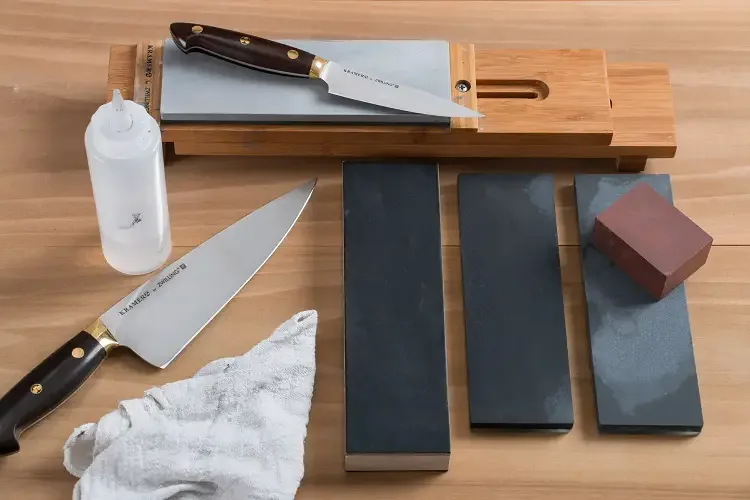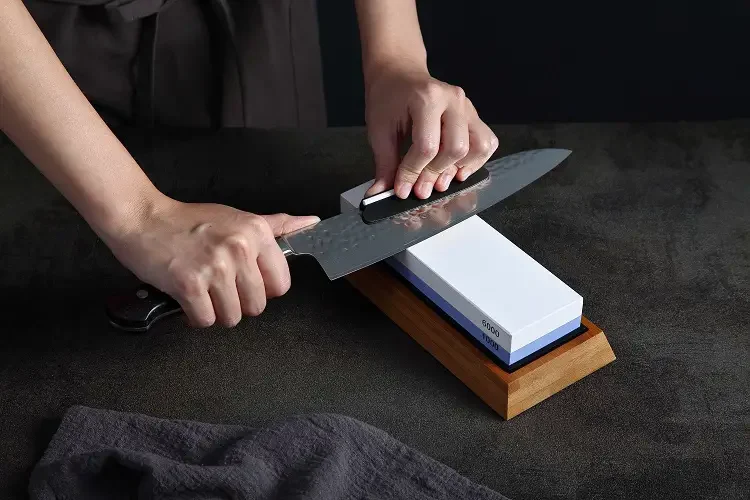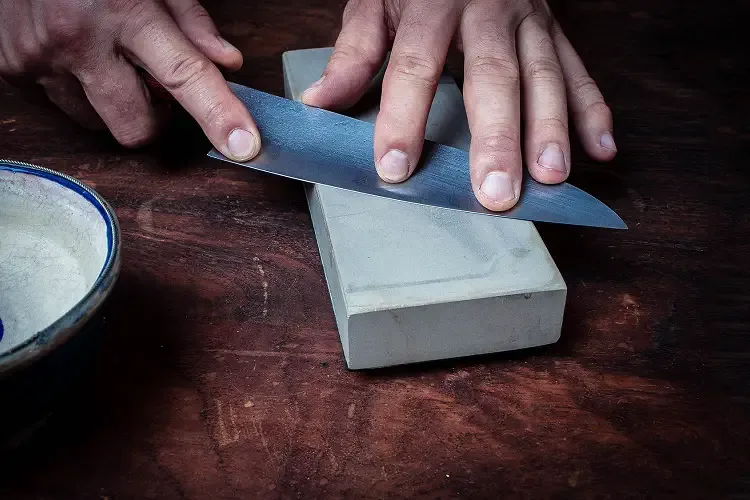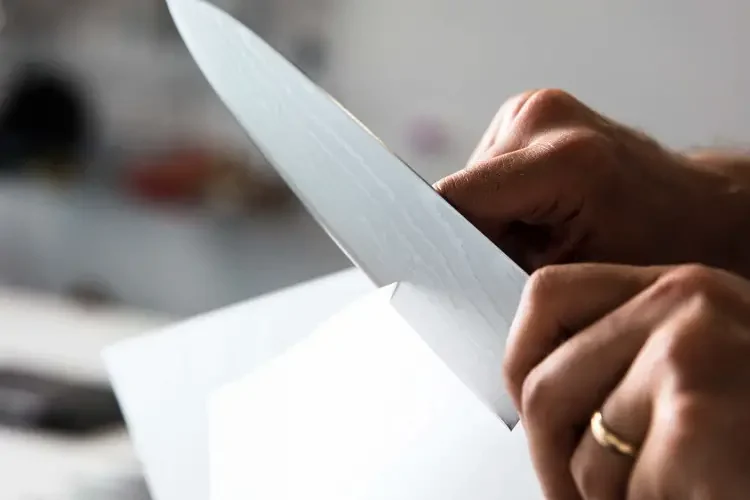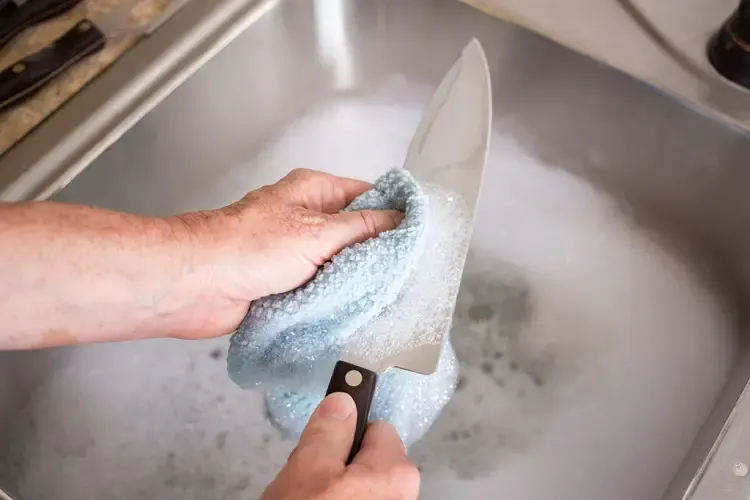SHTFDad may collect a share of sales or other compensation from the links on this page.
Welcome to the ultimate guide on mastering the art of sharpening! If you want to unleash the cutting power of your dull knives, look no further.
This guide shows you how to sharpen a knife with a stone. It’s a timeless method trusted by chefs and knife lovers worldwide.
Sharpening a knife with a stone removes dull and worn metal from the edge of the blade. It allows you to get a sharp and precise cutting surface. Using a stone provides several advantages over other sharpening methods.
It gives you complete control over the angle and pressure exerted on the blade. So you ensure a consistent and razor-sharp edge. In addition, sharpening stones are durable, economical and provide an enjoyable hands-on experience. They introduce you to the ancient art of blade care.
So get ready to embark on a journey to sharpen a knife. Follow our step-by-step instructions and tips. Soon you will know how to sharpen a knife with a stone. Let’s dive into the fascinating world of knife sharpening with a stone!
Essential Tools for Sharpening Success
So, are you looking for a proper way to sharpen a knife? Then you need a sharpening stone.
But you understand that a stone is not the only thing that will help you. You need to have the right tools at your disposal for optimal results. Here are the basic tools you’ll need for successful sharpening:
- Sharpening stone – Buy a high-quality sharpening stone with different grit sizes (coarse, medium, and fine). You need to adjust to different levels of blade bluntness.
- Sharpening guide – The sharpening guide helps maintain a consistent sharpening angle. It ensures that the entire process is uniform.
- Lubrication – Using honing oil or water as a lubricant on the stone helps reduce friction. You can keep the surface of the stone clean.
- Protective equipment – Protect your hands with a cut-resistant glove. Wear safety glasses to avoid accidents.
- Cleaning supplies – Keep a brush or rag handy to clean the stone after each use. Take another mild detergent for a thorough cleaning when needed.
Armed with these essential tools, you will be well prepared for the best way to sharpen a knife.
Step-by-Step Guide: Sharpening Your Knife with a Stone
Knife sharpening with a stone is a timeless and effective method. It ensures that your blades are razor-sharp and ready for any task. But why do you need to sharpen your knife in the first place?
Sharpening your knife is necessary for several reasons. First, a sharp knife provides an efficient and accurate cut. Dull knives require more effort. It increases the risk of slipping and getting into an accident.
In addition, a sharp blade makes clean cuts. They maintain the integrity and presentation of ingredients. Sharpening also helps maintain the knife’s longevity by preventing excessive wear and tear. Dull blades can cause unnecessary stress on the edge of the knife. It leads to chipping and warping.
By sharpening your knife regularly, you improve the knife’s performance. You are extending its life. It makes it a worthy investment for any cooking enthusiast. Follow this step-by-step guide to learn how to sharpen a knife with a stone:
Step 1: Prepare the Stone
Soak the sharpening stone in water for about 10-15 minutes.
It will allow the stone to absorb the water and prevent excessive friction. Place the stone on a non-slip surface or use a stone holder to secure it.
Step 2: Set the Angle
Determine the proper way to sharpen a knife. Most kitchen knives have a bevel angle of 15 to 20 degrees.
If you are unsure, refer to the manufacturer’s recommendations. Use a honing guide for better control. This way, you can maintain a constant angle throughout the process.
Step 3: Start with the Coarse Grit
Start with the coarse side of the sharpening stone. Hold the knife at the selected angle and grasp the handle firmly.
Start sharpening a knife with a stone from the base of the blade. Gently run the knife across the stone sweepingly, moving toward the tip.
Apply light pressure and ensure the entire edge is in contact with the stone. Repeat this process 5-10 times, keeping a constant angle.
Step 4: Switch to the Medium Grit
After you have provided a satisfactory edge, turn the stone over to the medium grit side. Repeat the sharpening process using the same technique as before.
The medium grit will further sharpen the edge. It will remove any remaining burrs and improve the sharpness of the blade.
Step 5: Finish with the Fine Grit
Now it’s time to move to the fine-grit side of the stone. This final step will polish the edge to achieve a razor-sharp finish.
Repeat the same sharpening motion, making sure to maintain the correct angle. Use a lighter touch and perform fewer strokes than with the previous grits.
Remember to sharpen both sides of the blade equally to maintain symmetry.
Step 6: Test and Refine
After sharpening, wipe the blade thoroughly with a clean cloth. You can remove metal shavings after the best way to sharpen a knife.
Check the knife’s sharpness by gently cutting a piece of paper or a ripe tomato. If the blade glides through effortlessly, you’ve successfully sharpen your knife.
However, if it is not as sharp as you would like, repeat the process. Start with a coarse grit and work up to a fine one. Do this until you get a good result.
Step 7: Clean and Store
Once you are satisfied with the sharpness, wash the knife thoroughly. Dry it completely to prevent moisture buildup.
It can lead to corrosion. Store the newly sharpened knife in a safe place to protect and keep the blade sharp.
Expert Tips for Long-lasting Blade Brilliance
Congratulations on sharpening your knives to perfection!
To ensure the longevity of their sharpness and maintain their brilliance, here are some expert tips to follow:
- Proper Storage – Once you know how to sharpen a knife with a stone, you must store it properly. Store your knives in a knife block, sheath, or on a magnetic strip. This way, you protect the edge of the blade from unnecessary contact.
- Safe Handling – Avoid cutting on hard surfaces like glass or stone, as it can quickly dull the blade. Opt for softer cutting boards made of wood or plastic to preserve the sharpness of your knives.
- Handwashing Only – Always handwash your knives with mild dish soap and warm water. Avoid placing them in the dishwasher, as the harsh detergents and high heat can damage the blade.
- Regular Maintenance – Regularly inspect your knives for any signs of damage, such as chips or bends. If necessary, have them professionally serviced or sharpened to ensure optimal performance.
By following these expert tips, you’ll maximize the lifespan of your newly sharpened knives and enjoy their brilliant cutting power for a long time to come.
Final Thoughts
Finally, learning how to sharpen knives with a stone is a crucial skill that will improve your cooking experience.
You’ll reap the benefits of accurate and effortless cutting in the kitchen if you put time and effort into sharpening and maintaining your knives.
Remember that the right tools, procedures, and maintenance are essential for maintaining long-lasting blade brilliance.
Sharpen with confidence, treat your knives with care, and revel in the delight of owning sharp and dependable cooking equipment. Happy cooking and sharpening!
References:

